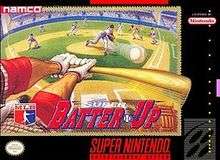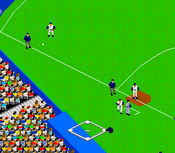Super Batter Up
| Super Batter Up | |
|---|---|
 Packaging for the Super NES version. | |
| Publisher(s) | Namco[1] |
| Designer(s) | Masahiro Shimamoto |
| Composer(s) |
Yoshinori Kawamoto[2] Shinya Yamada[2] |
| Series | Family Stadium |
| Platform(s) | Super NES |
| Release date(s) | |
| Genre(s) | Traditional sports[1] (arcade baseball) |
| Mode(s) |
Single-player Multiplayer |
Super Batter Up (スーパーファミスタ Super Famista) is a baseball video game with both a one- and two-player mode plus a league mode.[3]
The North American release has an official license from the Major League Baseball Players Association and features the names of actual professional baseball players. However, it does not have a license from Major League Baseball, so no actual team names are used, only their respective cities. While the all-star mode in the Japanese version of the game closely mimics the Nippon Professional Baseball All-Star Series, the North American version of the game emulates the MLB All-Star Game. An intrasquad mode (found only in the Japanese version) allows players on the same time to face off against each other. The only limitations are that there are only five pitchers on each team, players cannot be changed, and uniforms are limited to red and white colors.
Gameplay

The game features teams representing the 26 Major League Baseball teams and their players from the 1991 Major League Baseball season.[3] Ballplayers who competed during that baseball season like Cal Ripken, Dave Winfield, and Kirby Puckett are included.[4] However, the Japanese version was released featuring teams and actual player names from the Nippon Professional Baseball league. Players get to play in either a dome resembling the Tokyo Dome in Japan or Rogers Centre in Toronto, a contemporary baseball stadium (with homages to Japan's Koshien Stadium or Chicago's Wrigley Field), or in traditional-style stadium style (reminiscent of Chiba Marine Stadium in Japan or Busch Memorial Stadium in St. Louis).[3] Each player in the Japanese version of the game has a popularity meter that gauges how liked they are by the audience; better players are more likely to be cheered on for an excellent play.[5]
Players are shown standing up for the national anthem of both the United States and Canada (when the home team is Toronto or Montreal).[6] They can also choose to substitute a hitter or a runner while at bat.[3] All game stats are shown on the fictitious newspaper, known as the Namco Sports paper. Players are permitted to zoom in and out of the paper to look for minor details. The words "game over" appear on the screen regardless of whether the player wins or loses a game. Passwords can be entered to restore progress in the game. Both one-player and two-player modes integrates the traditional playing mode of the game. If the player wins the single-player tournament, then he can see the ending. The battle mode becomes a single-game mode when two players are playing. While the Japanese version of this game uses super deformed graphics for the ballplayers, the North American version uses 2D rendering software to create more realistic graphics.
The single-player league play mode keep tracks of all the players statistics during the season. Pitchers are considered to be "cold" when their ERA is above 9.90. An "average" hitter for season mode would theoretically have a batting average of .300 and 30 home runs while the "average" pitcher would have an ERA of 3.00 along with a fastball of 150 kilometres per hour (93 mph).[5]
Stadium dimensions
- Dome: Artificial turf with each side lasting 100 metres (330 ft) and the center lasting for 122 metres (400 ft)
- Modern/contemporary stadium: Artificial turf with each side lasting 91 metres (299 ft) and the center lasting for 118 metres (387 ft)
- Traditional stadium: Natural grass with each side lasting 97 metres (318 ft) and the center lasting for 120 metres (390 ft)
| Reception | ||||||
|---|---|---|---|---|---|---|
| ||||||
See also
References
Notes
- 1 2 3 4 "Release information". GameFAQs. Retrieved 2011-05-28.
- 1 2 "Composer information". SNES Music. Retrieved 2011-05-29.
- 1 2 3 4 "Basic overview of game". MobyGames. Retrieved 2011-05-28.
- ↑ "Basic summary of baseball players". IGN. Retrieved 2011-05-29.
- 1 2 "Advanced summary of baseball players" (in Japanese). Famista. Retrieved 2013-06-17.
- ↑ "National anthem information". allgame. Retrieved 2011-05-29.
Bibliography
- Fighting Studio (April 1992). Super Famista Hisshō Kōryaku-Hō スーパーファミスタ必勝攻略法 [Super Famista: Winning Strategy]. スーパーファミコン完璧攻略シリーズ. 10. Futabasha. ISBN 4-575-28161-1.
- Hippon Super! editorial staff (April 1992). Super Famista no Subete スーパーファミスタのすべて [All About Super Famista]. JICC Publishing Inc. ISBN 4-7966-0315-8.